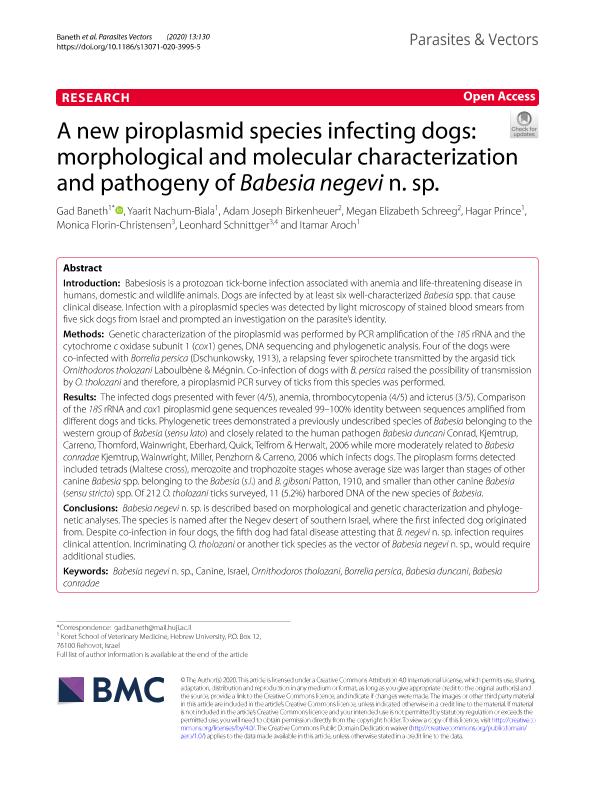Mostrar el registro sencillo del ítem
dc.contributor.author
Baneth, Gad
dc.contributor.author
Nachum Biala, Yaarit
dc.contributor.author
Birkenheuer, Adam Joseph
dc.contributor.author
Schreeg, Megan Elizabeth
dc.contributor.author
Prince, Hagar
dc.contributor.author
Jacobsen, Monica Ofelia

dc.contributor.author
Schnittger, Leonhard

dc.contributor.author
Aroch, Itamar
dc.date.available
2021-10-18T11:30:43Z
dc.date.issued
2020-04
dc.identifier.citation
Baneth, Gad; Nachum Biala, Yaarit; Birkenheuer, Adam Joseph; Schreeg, Megan Elizabeth; Prince, Hagar; et al.; A new piroplasmid species infecting dogs: Morphological and molecular characterization and pathogeny of Babesia negevi n. sp.; BioMed Central; Parasites and Vectors; 13; 1; 4-2020; 1-13
dc.identifier.issn
1756-3305
dc.identifier.uri
http://hdl.handle.net/11336/143990
dc.description.abstract
Introduction: Babesiosis is a protozoan tick-borne infection associated with anemia and life-threatening disease in humans, domestic and wildlife animals. Dogs are infected by at least six well-characterized Babesia spp. that cause clinical disease. Infection with a piroplasmid species was detected by light microscopy of stained blood smears from five sick dogs from Israel and prompted an investigation on the parasite's identity. Methods: Genetic characterization of the piroplasmid was performed by PCR amplification of the 18S rRNA and the cytochrome c oxidase subunit 1 (cox1) genes, DNA sequencing and phylogenetic analysis. Four of the dogs were co-infected with Borrelia persica (Dschunkowsky, 1913), a relapsing fever spirochete transmitted by the argasid tick Ornithodoros tholozani Laboulbène & Mégnin. Co-infection of dogs with B. persica raised the possibility of transmission by O. tholozani and therefore, a piroplasmid PCR survey of ticks from this species was performed. Results: The infected dogs presented with fever (4/5), anemia, thrombocytopenia (4/5) and icterus (3/5). Comparison of the 18S rRNA and cox1 piroplasmid gene sequences revealed 99-100% identity between sequences amplified from different dogs and ticks. Phylogenetic trees demonstrated a previously undescribed species of Babesia belonging to the western group of Babesia (sensu lato) and closely related to the human pathogen Babesia duncani Conrad, Kjemtrup, Carreno, Thomford, Wainwright, Eberhard, Quick, Telfrom & Herwalt, 2006 while more moderately related to Babesia conradae Kjemtrup, Wainwright, Miller, Penzhorn & Carreno, 2006 which infects dogs. The piroplasm forms detected included tetrads (Maltese cross), merozoite and trophozoite stages whose average size was larger than stages of other canine Babesia spp. belonging to the Babesia (s.l.) and B. gibsoni Patton, 1910, and smaller than other canine Babesia (sensu stricto) spp. Of 212 O. tholozani ticks surveyed, 11 (5.2%) harbored DNA of the new species of Babesia. Conclusions: Babesia negevi n. sp. is described based on morphological and genetic characterization and phylogenetic analyses. The species is named after the Negev desert of southern Israel, where the first infected dog originated from. Despite co-infection in four dogs, the fifth dog had fatal disease attesting that B. negevi n. sp. infection requires clinical attention. Incriminating O. tholozani or another tick species as the vector of Babesia negevi n. sp., would require additional studies.
dc.format
application/pdf
dc.language.iso
eng
dc.publisher
BioMed Central

dc.rights
info:eu-repo/semantics/openAccess
dc.rights.uri
https://creativecommons.org/licenses/by/2.5/ar/
dc.subject
BABESIA CONRADAE
dc.subject
BABESIA DUNCANI
dc.subject
BABESIA NEGEVI N. SP.
dc.subject
BORRELIA PERSICA
dc.subject
CANINE
dc.subject
ISRAEL
dc.subject
ORNITHODOROS THOLOZANI
dc.subject.classification
Otras Ciencias Veterinarias

dc.subject.classification
Ciencias Veterinarias

dc.subject.classification
CIENCIAS AGRÍCOLAS

dc.title
A new piroplasmid species infecting dogs: Morphological and molecular characterization and pathogeny of Babesia negevi n. sp.
dc.type
info:eu-repo/semantics/article
dc.type
info:ar-repo/semantics/artículo
dc.type
info:eu-repo/semantics/publishedVersion
dc.date.updated
2021-03-05T18:49:10Z
dc.journal.volume
13
dc.journal.number
1
dc.journal.pagination
1-13
dc.journal.pais
Reino Unido

dc.journal.ciudad
Londres
dc.description.fil
Fil: Baneth, Gad. The Hebrew University of Jerusalem; Israel
dc.description.fil
Fil: Nachum Biala, Yaarit. Koret School Of Veterinary Medicine; Israel
dc.description.fil
Fil: Birkenheuer, Adam Joseph. North Carolina State University; Estados Unidos
dc.description.fil
Fil: Schreeg, Megan Elizabeth. North Carolina State University; Estados Unidos
dc.description.fil
Fil: Prince, Hagar. North Carolina State University; Estados Unidos
dc.description.fil
Fil: Jacobsen, Monica Ofelia. Instituto Nacional de Tecnologia Agropecuaria. Centro de Investigacion En Ciencias Veterinarias y Agronomicas. Instituto de Patobiologia Veterinaria. - Consejo Nacional de Investigaciones Cientificas y Tecnicas. Oficina de Coordinacion Administrativa Pque. Centenario. Instituto de Patobiologia Veterinaria.; Argentina
dc.description.fil
Fil: Schnittger, Leonhard. Instituto Nacional de Tecnologia Agropecuaria. Centro de Investigacion En Ciencias Veterinarias y Agronomicas. Instituto de Patobiologia Veterinaria. - Consejo Nacional de Investigaciones Cientificas y Tecnicas. Oficina de Coordinacion Administrativa Pque. Centenario. Instituto de Patobiologia Veterinaria.; Argentina
dc.description.fil
Fil: Aroch, Itamar. Koret School Of Veterinary Medicine; Israel
dc.journal.title
Parasites and Vectors

dc.relation.alternativeid
info:eu-repo/semantics/altIdentifier/url/https://parasitesandvectors.biomedcentral.com/articles/10.1186/s13071-020-3995-5
dc.relation.alternativeid
info:eu-repo/semantics/altIdentifier/doi/http://dx.doi.org/10.1186/s13071-020-3995-5
Archivos asociados
